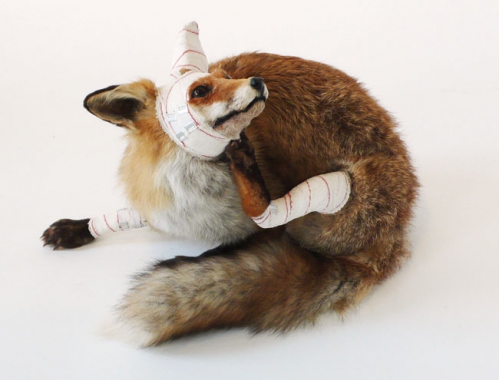Accident de chasse, par Pascal Bernier
Pascal Bernier's fatal toys
Fairy stories are definitely a thing of the past. If once upon a time there was an age when humanity could still believe in the profoundly miraculous nature of the world, it was because it was still untouched by these techno-sciences which since the modern age have enabled cruelty to expand systematically. As the witnesses and sometimes victims of this dehumanisation process, artists have on several occasions given us extremely scathing illustrations of this increasingly mechanical evolution. The science-fiction of the early 20th century with a film like Metropolis, or the "futurist" glass globe scenario, or closer to home, Warhol's Electric Chair as early as the 1960s anticipates the shock of an encounter with "Forbidden America".
This disenchanted world which has lost the innocence of its "paradise" is what P. Bernier now depicts for us as a vast laboratory of violence, where he cynically admits he works "without anaesthetic".
Also, instead of chloroformed regrets, the artist prefers to cut into the quick of the subject and with desperate energy take on a battle which enables him to confront as a tragic-comic hero the increasingly "cheap" morbidity of his time. In order to answer this both aesthetic and ethical emergency, several works focus on objects such as children's toys, which have difficulty in coming to terms with the loss of the "perfect world" to which they were attached. From this point of view, the Hunting accidents and Farm Sets series form one of the most exemplary statements on this fallen nature, where Bambis are now game and "Animal Farm" -to borrow Orwell's title- is a concentration camp universe. As repetitive as the oil slicks, animal tortures and ethnic genocides of our daily realities, these images of blindfolded animals or furry toys and "virtual landscapes" thus follow on from one another in the stream of works like a disaster that can not be stemmed. For in this artist's work, there is also a keen awareness of the irreversibility oftime which certain philosopher scientists have identified through the description of physical systems referred to as "unstable". Translated in terms of fractal geometry and statisticallaws, this paradoxical vision of programmed chaos as an end in itself -probably the amplification of an original instability- gives the work its utterly nightmarish dimension. From this point of view, the "butterfly effect" which was the principal tool in the popularisation of chaos theories is not unrelated to these pieces entitled WWF, for which Bernier grafted fighter plane roundels onto the wings of several species of insects, as a sign -who knows?- of some new kind of future micro-biological war. Just like model aircraft boxes, these little transfers also refer to a childhood world whose playful activities are not as innocent as they may on first sight appear. On the toy shelves of our supermarkets, the arms' race is in full swing, even if morality is draped in the Heroic Fantasies costumes of Spider Man or Super Man. Along the same lines, we can also cite such series as cooked Battlefield or Beach Guns, which make use of the apparently contrad ictory telescoping technique albeit against the cruelly true background of leisure activities and war: the former by frying up little lead soldiers, the second by making sand castles in the shape of revolvers.
Denis Gielen
